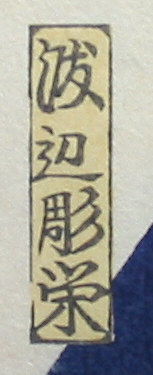
JAPANESE PRINTS
A MILLION QUESTIONS
TWO MILLION MYSTERIES
Ukiyo-e Prints浮世絵版画 |
|
Port Townsend, Washington |
|
||
|
Title Cartouche: sho-ryo-fu-kan-mitsu-ga (?) |
||
|
Actors: |
||
|
Left Panel: Nakamura Shikan IV 中村芝翫 なかむらしかん |
||
|
Center Panel: Ichikawa Sadanji 市川左団次 いちかわさだんじ |
||
|
Right Panel: Bandō Shinsui V 坂東 薪水 ばんどう しんすい |
||
|
Print Sizes: 9 3/8" x 14 1/8" |
||
|
Date: 1873, Third Month Meiji 6 明治6 |
||
|
Publisher: Gusoku-ya Kahei 具足屋嘉兵衛 ぐそくやかへえ |
||
|
Carver: Watanabe Ei (?) 渡辺(彫)栄 わたなべえいい |
||
|
Signature found in red seal: Ginkō |
||
|
|
||
|
ORIGINALLY $480.00 NOW ON SALE FOR $330.00 SOLD! |
|
*Laurence P. Roberts in his Dictionary of Japanese Artists, p. 32, gives Ginkō's dates as fl. 1874-97. He notes that nothing is known about his life. However, the date seal should push the earliest date back by one year and may indicate on stylistic grounds alone that Ginkō had some connection to Kunichika's studio . |
In the Rijksprentkabinet's Catalogue of the Collection of Japanese Prints Part V: The Age of Yoshitoshi published in 1990 the author iterates that we know very little about Ginkō's life. His oeuvre ran the gamut of typical subjects created at the time: actors, beautiful women, caricatures and Sino-Japanese War triptychs. Then he adds: "Ginkō was one of the few Meiji artists to run afoul of the censorship laws. In 1889, he was sent to jail for publishing a cartoon on the receiving of the constitution by the Meiji emperor, in which the emperor was depicted as a skeleton." (p. 82) |
 |
|
|
||
| Ginkō's signature is found in the red seal at the bottom |
 |
具 足 屋 嘉 兵 衛 |
ぐ そ く や か へ え |
 |
||
|
Date Seal: 1873, 3rd Month |
|||||
|
Publisher's mark: Gusoku-ya Kahei |
 |
||||
|
Carver's seal: Watanabe Ei (?) |
|||||
|
The attribution to Kunichika is not only based on stylistic grounds and the fact that this publisher published other works by the artist, but also because there is a corresponding triptych of three onnagata in similarly creative portraits. However, the onnagata triptych clearly displays a signature cartouche on each panel. Like the images featured on this page this triptych is dominated by the obliquely angled deep purple and white banner. There is one other difference in that the reproduction of stitchery as shown here is lacking. |
|
An example of the onnagata triptych can be found for comparison on the Tsubouchi Memorial Theater Museum at Waseda University. Unfortunately this site is in Japanese only. |
 |
 |
 |
||
| Nakamura Shikan IV | Ichikawa Sadanji |
Bando Shinsui V |
||
| 中村芝翫 | 市川左団次 | 坂東薪水 | ||
| なかむらしかん |
いちかわさだんじ |
ばんどう しんすい |
| I want to thank A. for his special assistance. |
| THE FINEST KABUKI SITE ON THE INTERNET! |
|
http://www.kabuki21.com/index.htm Originally most of the site linked above was in French, but now nearly all of it is also in English. Many of the people who are reading this will already know of this site. But if you don't then go to it and definitely bookmark it as one of your 'favorites.' It will serve you well. There is material to be found there which is hard if not impossible to find anywhere else. This is a great site for students, collectors, dilettantes and the just plain curious. |
|
|
|
For additional information about and images by various artists of Nakamura Shikan IV link to the web site below. |
|
|
|
For more on Ichikawa Sadanji click on the link below. |
|
|
|
For more on Bandō Shinsui V better known as Bandō Hikosaburō V click on the link below. |
 HOME
HOME